
Saqqara, also spelled Sakkara or Saccara in English, is an Egyptian village in Giza Governorate, that contains ancient burial grounds of Egyptian royalty, serving as the necropolis for the ancient Egyptian capital, Memphis. Saqqara contains numerous pyramids, including the Step pyramid of Djoser, sometimes referred to as the Step Tomb, and a number of mastaba tombs. Located some 30 km (19 mi) south of modern-day Cairo, Saqqara covers an area of around 7 by 1.5 km.
KV55 is a tomb in the Valley of the Kings in Egypt. It was discovered by Edward R. Ayrton in 1907 while he was working in the Valley for Theodore M. Davis. It has long been speculated, as well as much disputed, that the body found in this tomb was that of the famous king, Akhenaten, who moved the capital to Akhetaten. The results of genetic and other scientific tests published in February 2010 have confirmed that the person buried there was both the son of Amenhotep III and the father of Tutankhamun. Furthermore, the study established that the age of this person at the time of his death was consistent with that of Akhenaten, thereby making it almost certain that it is Akhenaten's body. However, a growing body of work soon began to appear to dispute the assessment of the age of the mummy and the identification of KV55 as Akhenaten.
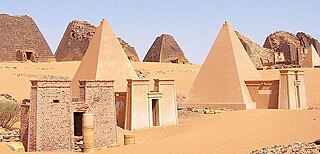
Meroë was an ancient city on the east bank of the Nile about 6 km north-east of the Kabushiya station near Shendi, Sudan, approximately 200 km north-east of Khartoum. Near the site is a group of villages called Bagrawiyah. This city was the capital of the Kingdom of Kush for several centuries from around 590 BC, until its collapse in the sixth century CE. The Kushitic Kingdom of Meroë gave its name to the "Island of Meroë", which was the modern region of Butana, a region bounded by the Nile, the Atbarah and the Blue Nile.
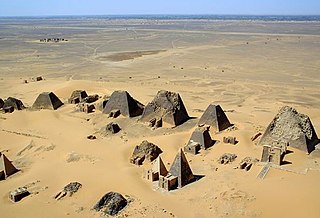
Nubian pyramids were built by the rulers of the ancient Kushite kingdoms. The area of the Nile valley known as Nubia, which lies within the north of present-day Sudan, was the site of three Kushite kingdoms during antiquity. The capital of the first was at Kerma. The second was centered on Napata. The third kingdom was centered on Meroë. The pyramids are built of granite and sandstone.

Neferkare Shabaka, or Shabako was the third Kushite pharaoh of the Twenty-fifth Dynasty of Egypt, who reigned from 705 to 690 BC.
Tomb KV60 is an ancient Egyptian tomb in the Valley of the Kings, Egypt. It was discovered by Howard Carter in 1903, and re-excavated by Donald P. Ryan in 1989. It is one of the more perplexing tombs of the Theban Necropolis, due to the uncertainty over the identity of one female mummy found there (KV60A). She is identified by some, such as Egyptologist Elizabeth Thomas, to be that of the Eighteenth Dynasty pharaoh Hatshepsut; this identification is advocated for by Zahi Hawass.

Kashta was an 8th century BC king of the Kushite Dynasty in ancient Nubia and the successor of Alara. His nomen k3š-t3 "of the land of Kush" is often translated directly as "The Kushite". He was succeeded by Piye, who would go on to conquer ancient Egypt and establish the Twenty-Fifth Dynasty there.
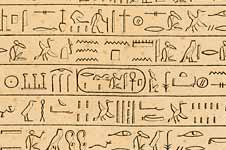
Alara was a King of Kush, who is generally regarded as the founder of the Napatan royal dynasty by his 25th Dynasty Kushite successors and was the first recorded prince of Kush. He unified all of Upper Nubia from Meroë to the Third Cataract and is possibly attested at the Temple of Amun at Kawa. Alara also established Napata as the religious capital of Kush. Alara himself was not a 25th dynasty Kushite king since he never controlled any region of Egypt during his reign compared to his two immediate successors: Kashta and Piye respectively. Nubian literature credits him with a substantial reign since future Nubian kings requested that they might enjoy a reign as long as Alara's. His memory was also central to the origin myth of the Kushite kingdom, which was embellished with new elements over time. Alara was a deeply revered figure in Nubian culture and the first Kushite king whose name came down to scholars.
Shanakhdakheto or Shanakdakhete was a Queen of the Kingdom of Kush, when the polity was centered at Meroë. She is the earliest known ruling African queen of ancient Nubia, and reigned from about 170 to 150 BC, although the period 170–160 BC is also mentioned. She is said to have ruled with full power in the Meroë Empire. She is also said to have ruled without a king. It is also stated that as queen she played a significant role in the Meroitic religion. In the 2nd century BC Shanakdakheto built the Temple F at Naqa, which has an unusual feature in the first half of the temple with the interior partitions where the gods face the back wall.

Nuri is a place in modern Sudan on the west side of the Nile, near the Fourth Cataract. Nuri is situated about 15 km north of Sanam, and 10 km from Jebel Barkal.

Aramatle-qo or Amtalqa was a Meroitic king.
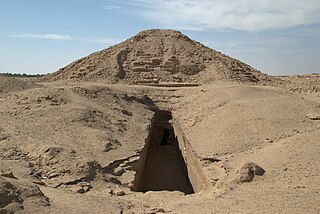
El-Kurru was one of the royal cemeteries used by the Nubian royal family of Kush and Egypt's 25th Dynasty. It is now located in Northern state, Sudan. Excavated by George Reisner, most of the royal Nubian pyramids date to the early part of the Kushite period, from Alara of Nubia to King Nastasen.
Atakhebasken (Akhetbasaken) was a Nubian queen dated to the Twenty-fifth Dynasty of Egypt. She was the Great Royal Wife of Pharaoh Taharqa.

The Pyramids of Meroë are part of the larger group of Nubian pyramids, built at the time of the Kushite Kingdom over a period close to a millennium. Near Meroë, three royal cemeteries were constructed:

Malewiebamani was a Kushite King of Meroe.

Amanineteyerike was a Kushite King of Meroe. His reign is dated to the end of the 5th century BCE.
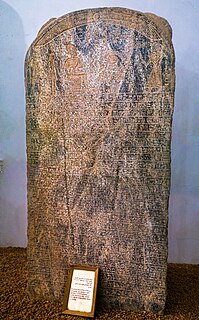
Siaspiqa was a ruler of the Kushite kingdom of Meroë reigning for close to twenty years in the first half of the 5th century BC. Very little is known of Siaspiqa's activities beyond the construction of his pyramid at Nuri, now known as Nuri 4. The pyramid and its chapel have yielded several inscribed stelas bearing his name as well as numerous artefacts suggesting a once rich burial. Nothing is known for certain on the relations between Siaspiqa and his predecessor Amaniastabarqa and successor Nasakhma. Equally uncertain is the identity of his consort, with queen Pi'ankhqewqa buried in the nearby Nuri 29 conjectured for that role.

Talakhamani was a Kushite King of Meroe during the second half of the 5th century BCE. No prenomen is known, and his nomen is Talakhamani. He may have been a son of Nasakhma and a younger brother of Malewiebamani. It is also possible Talakhamani is a son of Malewiebamani.

Amaniastabarqa was a Kushite king of Meroë who ruled in the late Sixth or early Fifth centuries BC, c. 510–487 BCE.














